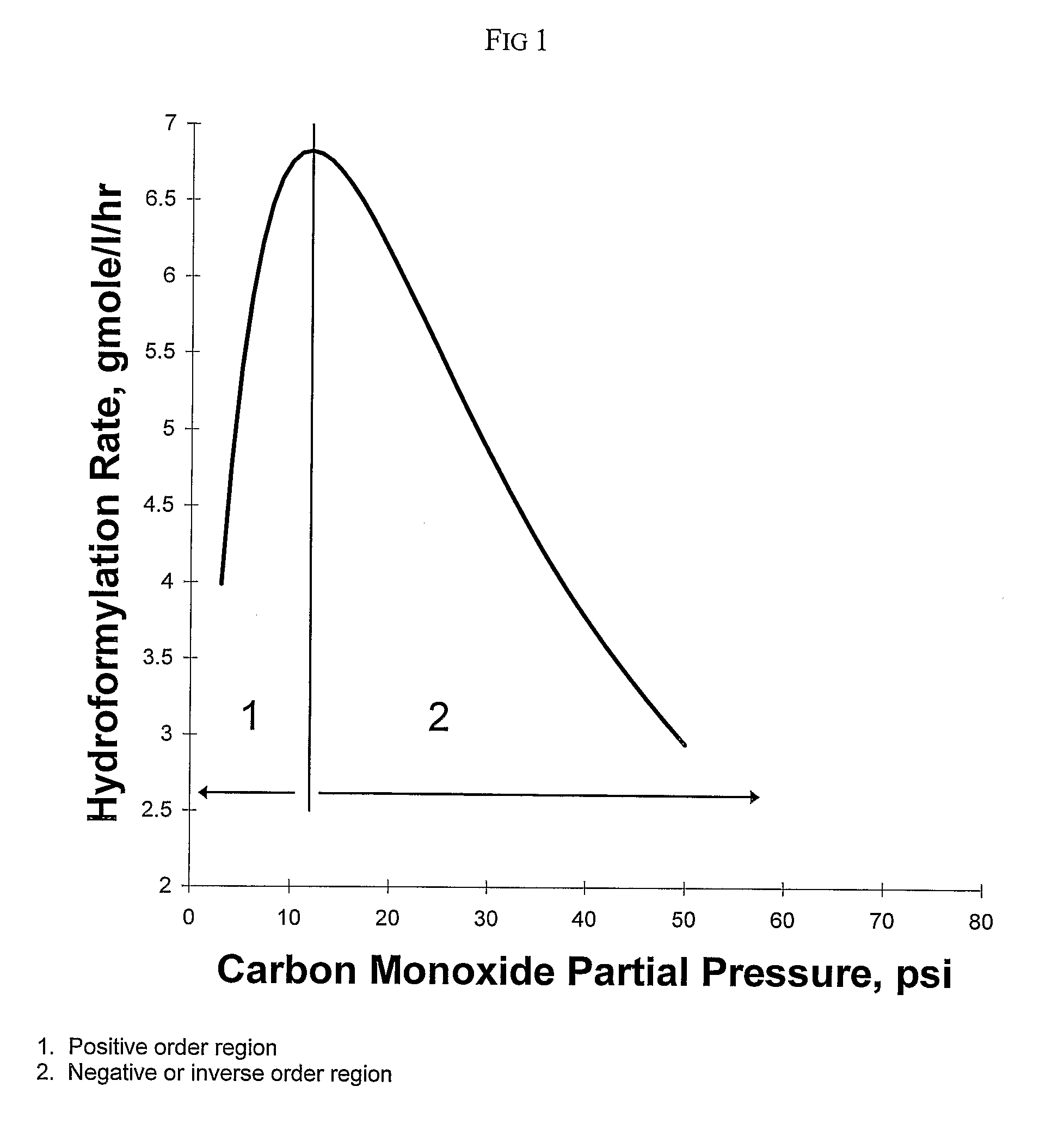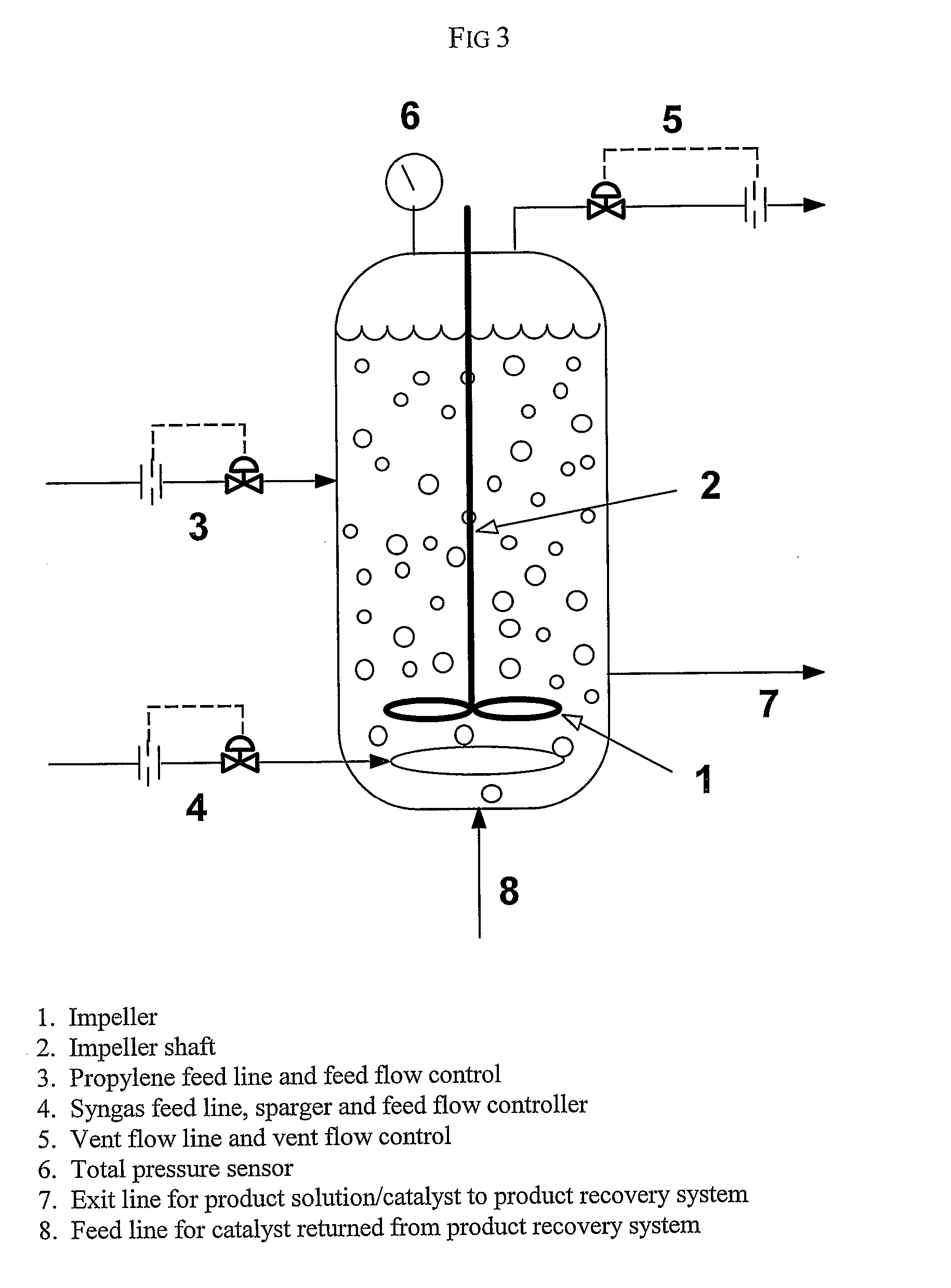Stabilization of a hydroformylation process
a hydroformylation process and hydroformylation technology, applied in the direction of carbonyl compound preparation, liquid degasification, separation processes, etc., can solve the problems of loss of catalyst or catalytic activity, decrease in catalyst productivity, increase in production costs of aldehyde products, etc., to prevent and/or lessen the cycling of process parameters, reduce the cost of catalyst production, and stabilize reaction rate and process parameters
- Summary
- Abstract
- Description
- Claims
- Application Information
AI Technical Summary
Benefits of technology
Problems solved by technology
Method used
Image
Examples
example 1
[0168]This example illustrates the method of the invention for determining a primary amount of synthesis gas feed flow rate for operation in the inverse carbon monoxide partial pressure region of operation. A reactor was configured as shown in FIG. 3. The reactor was equipped with an impeller (1), impeller shaft (2), propylene feed line and feed flow control (3); syngas feed line and feed flow control (4), the feed line terminating in a sparger in the reactor; vent flow line and vent flow control (5), total pressure sensor (6), exit line for product solution / catalyst to product recovery system (7), and feed line for catalyst returned from product recovery system (8). During the experiment the propylene feed flow rate and reactor vent flow rate were maintained constant within practical limits. To maintain a constant catalyst liquid level and achieve steady-state operation, a portion of the reaction solution was continuously removed from the reactor and passed through a product recove...
example 2
[0173]Example 2 illustrates stable operation of a hydroformylation process in the negative order region of the hydroformylation rate curve in accordance with the invention. The reactor was configured as shown in FIG. 4, which was identical to the reactor configuration of FIG. 3 with the exception that the syngas feed flow control comprised primary (4) and secondary (9) flow control valves. Operating parameters were controlled in a manner similar to Example 1. A primary amount of synthesis gas was fed to the reactor through the primary synthesis gas flow rate controller (4). In response to deviations of the measured total pressure from the target pressure of 120 psig (827 kPa), an additional amount of synthesis gas was fed through the secondary forward pressure regulator (9) to adjust the total reactor pressure to the target pressure. The reaction conditions were maintained until steady-state conditions were achieved as indicated by a constant total reactor pressure and constant hydr...
example 3
[0178]This example illustrates how to bring stable operation to the reaction system of Comparative Experiment 1. From the final conditions described in Comparative Experiment 1, the total synthesis gas feed rate was decreased to 180 SLH, and the time clock was set back to 0, Subsequently, at 0.20 hours of operation the total reactor vent flow rate had decreased below 17 SLH, and at that point the reactor was rapidly reconfigured (9). Without any further changes, the reaction system quickly reestablished the desired stable operating conditions similar to those in Example 2. The following operating conditions were maintained: propylene feed rate, 299 grams / hour; internal catalyst temperature, 75° C.; syngas feed ratio (H2:CO), 1.06 with a primary feed flow rate of 202 SLH; total reactor pressure, 120 psig (using the synthesis gas feed pressure regulator); and reactor vent flow rate, 44 SLH. The reactor vent flow rate of 44 SLH was sufficient to purge inert components and by-products f...
PUM
| Property | Measurement | Unit |
|---|---|---|
| carbon monoxide partial pressure | aaaaa | aaaaa |
| temperature | aaaaa | aaaaa |
| temperature | aaaaa | aaaaa |
Abstract
Description
Claims
Application Information
 Login to View More
Login to View More - R&D
- Intellectual Property
- Life Sciences
- Materials
- Tech Scout
- Unparalleled Data Quality
- Higher Quality Content
- 60% Fewer Hallucinations
Browse by: Latest US Patents, China's latest patents, Technical Efficacy Thesaurus, Application Domain, Technology Topic, Popular Technical Reports.
© 2025 PatSnap. All rights reserved.Legal|Privacy policy|Modern Slavery Act Transparency Statement|Sitemap|About US| Contact US: help@patsnap.com



